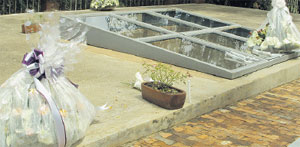Harold Ayodo
It was shortly after 2pm on Monday when the pilot announced the flight from Nairobi was about to land in Kigali, Rwanda, the cleanest city in Africa.
Though I had heard that a recent United Nations Habitat for Humanity poll had nominated Kigali as the cleanest city in Africa, I had dismissed it just as an exaggeration. |
Taxi motos (motor bikes) are the main form of transport in Kigali. |
However, I sensed something in the whole thing when flight attendants warned passengers against disembarking with polythene bags or any plastic containers. The instructions were further repeated in different languages as we unfastened our seat.
Kigali International Airport is spotlessly clean, though I didn’t think much of it because every country keen to make an impression on her guests, keeps their entry points clean.
But driving away from the airport to the Top Tower Hotel where we were to put up was a breathtaking experience.
It was a smooth ride, the smoothest I have ever experienced since I started riding in vehicles. Unlike back home there was no traffic jam and potholes seemed like a strange word here.
The land of a thousand hills is green and neat with professional landscaping done on virtually every street. Municipal employees could be seen mowing grass along the highways as we drove by.
According to the council of Kigali, this 103-year-old city still has a vision to make it cleaner and safer, an envy of other nations. The air is fresh, thanks to the beautiful trees and plants, which the municipality waters during dry spells.
Friendly people
Kigali is a beautiful destination with friendly people and good infrastructure — a surprise for a country that suffered genocide 16 years ago. Looking at the people going about their businesses on the streets, it’s hard to tell that they had gone through such a violent phase in their history.
Kigali, at the heart of Rwanda, is the economic, cultural, and transport hub of the country. Modern commercial and residential buildings are among the major developments in the capital city.
The city’s hilly terrain, sprawling across about four ridges and the valleys in between accentuates its beauty and easily reminds one of the Biblical Mount Zion. The city centre is located on one of the ridges, with the main government area on another. A ring of higher hills, some with suburban homes, surrounds the entire city. Public transport within Kigali is exclusively by taxi minibus and taxi moto (motor bikes).
Furthermore, the public transport connects a number of hubs and routes including Mu (Mujyi), referring to the city centre, Nyabugogo, Kacyiru, Kimironko and Remera.
However, roads and streets in Kigali have no names and this can be confusing especially for first time visitors. The discomfort is, however, temporary when compared to the locals’ readiness to assist.
Four wheel drives
Due to the terrain, Land Cruisers, Mercedes Benz and other powerful fuel guzzlers dot the smooth roads. If you thought Kenyans love big cars, welcome to Kigali.
At the Top Tower Hotel I was ushered in with a glass of freshly-squeezed passion juice by a beautiful Rwandese girl. She uttered some words in French. From the smile, I assumed it must have been a greeting.
"I do not speak French but English and Swahili…do you speak English?" I asked the receptionist who nodded. I came to learn that she was also fluent in Kinyarwanda.
Rwanda is home to three ethnic groups: the Hutus (about 85–90 per cent of the population), Tutsi (10–15 per cent), and the Twa (less than one per cent). The cultures of the three ethnic groups, however, have a lot in common for instance they have spoken the same language for at least 500 years.
In Kigali, all locals speak Kinyarwanda, a Bantu language that I must confess sounded like a complex jargon. I came to learn that the language has over 20 different nouns compared with English that has only two: singular and plural. The second preferred language especially among the learned is French.
African beauties
Locals in Kigali are humble and warm, and will not hesitate to extend a hug when they realise one is a visitor. Be warned, however, it’s not the intimate bear hug we are accustomed to. Theirs seem to follow a certain pattern with a person’s left hand touching the other’s hip as the right hand reaches up to touch the shoulder.
And women here cherish their natural beauty and proudly show it off. They are true African beauties, a combination of physical endowment, height and neat hair. On any day they would effortlessly turn heads in the streets of Nairobi, including mine.
Thierry Ingabire, a friend who doubled up as my tour guide, says their women’s humility can be traced right from their childhood.
"They are taught to be patient and respect their husbands…you will realise that women here smile genuinely to men they know," Ingabire says. |
Flowers at the genocide museum in Kigali. |
He says the women also love cooking; believing the traditional saying that the way to a man’s heart is through the stomach.
Two most common foods are plantains and beans, which are often boiled together. Another staple diet is sorghum grain used to cook porridge and to brew beer. Other common traditional foods are Irish potatoes, sweet potatoes, cassava and maize.
Memorial Centre
And although nyama choma (roast meat) is popular in Kenya, only wealthy Rwandans eat meat often and down it with Amstel beer.
"The most common meat is goat which, is usually barbecued over a charcoal burner… beef is the most valued," Ingabire says.
There are tourist attraction sites such as the Kigali Memorial Centre that is a must-visit for insights into the worst genocide in history. The memorial centre, locally known as the genocide museum, includes three permanent exhibitions, the largest of which documents the 1994 genocide. There is also a children’s memorial, and an exhibition on the history of genocide violence around the world.
The education centre, memorial gardens and national documentation centre of the genocide all pay tribute to those who perished. The mass grave where 258,000 victims of the genocide were buried is also within the compound of the museum.
Kigali Memorial Centre guide officer Serge Rwigambi says the facility is among the main attractions.
"We receive an average of 300 visitors on a slow day at the genocide museum most of who are moved by the accounts of the toddlers," Rwigambi says.
Anti-genocide laws
Rwigambi says most visitors, especially women, break down as they hear what innocent children went through in the genocide.
"Children are among the 258,000 victims buried in mass graves here within the compound of the memorial centre," Rwigamba says.
Rwigamba says former US Presidents Bill Clinton and George Bush Jr are among the high profile guests who were moved by the accounts of the genocide.
The museum acts as a memorial for those who died in the genocide and also as a place for the people of Rwanda to mourn the loss of their loved ones. It is the only place where visitors can exclusively get information on the mass killings, as most locals are tight lipped due to anti-genocide laws.
The Government passed laws to contain the dissemination of genocide ideology in a bid to avoid a repeat of the tribal flare-ups that led to the genocide. As we landed at Jomo Kenyatta International Airport, the flight attendants did not warn us against alighting with polythene bags and plastics.
 The Standard Group Plc is a multi-media organization with investments in media
platforms spanning newspaper print operations, television, radio broadcasting,
digital and online services. The Standard Group is recognized as a leading
multi-media house in Kenya with a key influence in matters of national and
international interest.
The Standard Group Plc is a multi-media organization with investments in media
platforms spanning newspaper print operations, television, radio broadcasting,
digital and online services. The Standard Group is recognized as a leading
multi-media house in Kenya with a key influence in matters of national and
international interest.
 The Standard Group Plc is a multi-media organization with investments in media
platforms spanning newspaper print operations, television, radio broadcasting,
digital and online services. The Standard Group is recognized as a leading
multi-media house in Kenya with a key influence in matters of national and
international interest.
The Standard Group Plc is a multi-media organization with investments in media
platforms spanning newspaper print operations, television, radio broadcasting,
digital and online services. The Standard Group is recognized as a leading
multi-media house in Kenya with a key influence in matters of national and
international interest.











